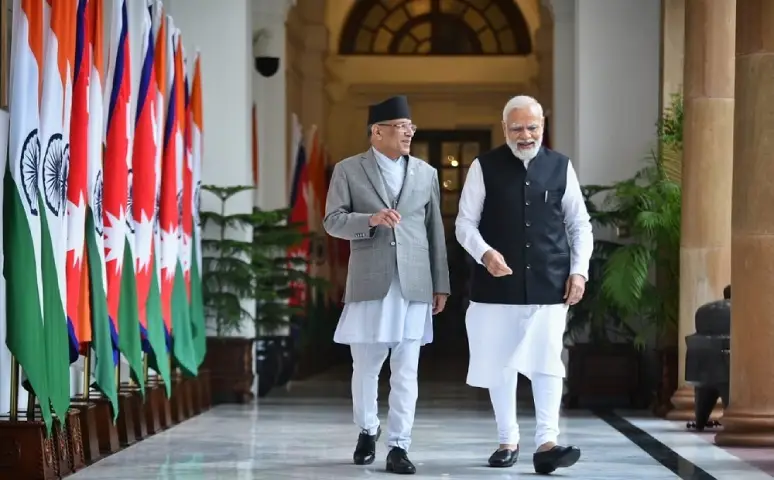Kathmandu: Nepal on Tuesday welcomed two major decisions that India has made, including cabinet approval for a long-term power trade pact.
New Delhi also granted approval for importing 180 MW of electricity that four power projects in Nepal generate.
When Nepali Prime Minister Pushpa Kamal Dahal visited India from May 31 to June 3, two sides had initialled the 25-year inter-governmental long-term power trade agreement. But formal signing of the agreement had not taken place as India’s cabinet had not endorsed the draft of agreement.
The agreement is important for both countries and particularly for Nepal as it would ensure a long-term market for Nepal’s power.
Prime Minister Narendra Modi had announced during the joint press meet with Nepali Prime Minister Dahal on June 1 that the southern neighbour would buy 10,000MW of electricity in 10 years from Nepal under the long-term power trade agreement. “Under this Agreement, we have set a target of importing 10,000 MW of electricity from Nepal in the coming ten years,” Modi had announced at the joint press meet.
India Cabinet okays plan to buy Nepal’s 10,000 MW powerhttps://t.co/xb60uoqHRk#NepalIndiaFriendship#RotiBeti @Shailen34696534 @viveka2405 @Megumi_kuroneko @Rekhathapas1 @sumanay_ @VS__THAPA @Sushasan @badal_poudel23 @MakarShrestha @Rohitstha1210 @yamuna_parajuli @2__r2 pic.twitter.com/1KtKxpLajA
— 🇳🇵 Nepal News Forum (@nepalnewfest) September 6, 2023
On Tuesday, Nepal’s Ambassador to India Shankar Sharma wrote on X, previously known as twitter, that India’s Cabinet approved the agreement to purchase 10,000MW of electricity from Nepal in the next 10 years.
“(This) has paved the way to develop a new road map for electricity development in Nepal. This could play a significant role in the economic development and restructuring of Nepal,” he said.
Nepal’s Energy Secretary Dinesh Ghimire also confirmed to India Narrative that the long-term agreement was endorsed by India’s cabinet. “We will soon invite the Indian officials to sign the agreement,” he said.
Alongside news about India’s cabinet endorsing the long-term power trade agreement, Nepal Electricity Authority (NEA) also confirmed that India has granted approval to Nepal to sell extra 180MW of electricity generated by four hydropower projects in Nepal. So far, Indian authorities have granted approval to sell only 452.6MW in the Indian market.
“New approval for 110MW of two projects was granted for exporting power under a medium term (five-year power sale agreement) signed between the NEA and NTPC Vidyut Vyapar Nigam Limited (NVVN),” said Prabal Adhikari, power trade director at Nepal Electricity Authority (NEA), the state-owned power utility body of Nepal.
On May 23, the NEA and the NVVN had signed the medium-term agreement in order to sell up to 200MW of power from Nepal to India. According to the NEA, it is the first time that Nepal would be selling its electricity under such a long-term deal, ensuring a durable market for Nepal’s power.
According to NEA, the electricity under medium-term agreement will be transmitted to India via Dhalkebar-Muzaffarpur Cross-Border Transmission Line that passes through eastern Nepal. Likewise, remaining 70MW power generated by two other projects will be sold to India’s day-ahead market via 132 kV Mahendranagar-Tanakpur Transmission line that passes through far-western Nepal, according to NEA.
tkp: Oli, Modi inaugurate Dhalkebar-Muzaffarpur cross-border transmission line… https://t.co/7RN2fNVLOq pic.twitter.com/aMuWOhoZvU
— Nepal News English (@Nepal_News_En) February 21, 2016
“These two decisions from the Indian side are a good gesture to Nepal that the southern neighbour is committed to its promises,” Ganesh Karki, president of Independent Power Producers’ Association of Nepal (IPPAN), a grouping of private sector power developers, told India Narrative. “Now, there is the challenge for the Nepal government to ensure that Nepal could produce the electricity to meet the target set in the agreement,” he added.
Nepal’s current generation capacity is around 3,000MW. The Himalayan country is projected to generate 5,251MW by July 2025 while domestic demand is projected to remain at 2,568MW, according to the NEA. This means, access to the Indian market is very important for Nepal.
Nepali officials and private sector representatives said that the signing of a long-term agreement would pave the way for increased domestic and foreign investment in Nepal’s power sector.
They expect the surge in Indian investment in Nepal’s power sector given that one of the key objectives of the long-term power trade agreement is to promote mutually beneficial investments in the hydropower generation and transmission line projects in Nepal, according to Nepali officials.
Madhu Bhetuwal, spokesperson at Nepal’s energy ministry said that the long-term agreement, once signed, would pave the way for investment in big hydropower projects in Nepal. “It is expected to promote investment of both Nepal and India in the country’s hydropower sector,” he said.
So far, there are limited Indian companies involved in development of hydropower projects in Nepal. India’s SJVN Limited, is developing the 900 MW Arun-3 Hydropower project in east Nepal. The Nepal government has also granted its licence to develop the 669 MW Lower Arun Hydropower Project while 490 MW Arun-4 hydro power project in the same river will be developed in collaboration with the NEA.
𝐀𝐫𝐮𝐧-𝟑 𝐇𝐲𝐝𝐫𝐨𝐩𝐨𝐰𝐞𝐫 𝐏𝐫𝐨𝐣𝐞𝐜𝐭
8️⃣Days to🔟YearsIBN Facilitated 900 MW Arun-3 Hydropower Project; the largest FDI project has achieved more than 40% overall progress in construction. #10yearsofibn #investinnepal pic.twitter.com/uCBevMXjy5
— Office of the Investment Board Nepal🇳🇵 (@IBNOffice) August 31, 2021
India’s NHPC Limited has been granted licences to develop the 750 MW West Seti and the 450 MW Seti River 6 project in western Nepal. The Indian company and Vidyut Utpadan Company Limited of Nepal also signed a Memorandum of Understanding to jointly develop the 480 MW Phukot Karnali Project in western Nepal during Dahal’s India visit. Indian Company GMR is also making efforts to develop the 900MW Upper Karnali Hydropower Project.
TKP: Court opens door for GMR to continue financial closure works to develop Upper Karnali Hydropower Project – https://t.co/dk9sakmx1V
— Nepal News English (@Nepal_News_En) May 9, 2023
IPPAN President Karki said that India guaranteeing access to its large market would help attract investment in Nepal’s hydropower sector from Nepal and other countries. “Until now, there was uncertainty about whether India would grant long-term market access to Nepal’s power. The signing of the long-term agreement will help convince the investors to pour their money in Nepal’s power sector,” he said.
Also Read: US funded programme to accelerate construction of Nepal-India cross border power line















